The Most Affordable Playground Surfaces in 2025 (with Photos)
15 Jun, 2024
Table of content
- The most affordable playground surfacing materials
- Poured-in-place rubber (PIP)
- Engineered wood fiber (EWF)
- Pea gravel
- Synthetic turf
- Sand
- So what is the most affordable playground surface?
- How to choose the best surfacing material for playground — Safestep recommendations
- Which playground surfacing material needs minimum maintenance?
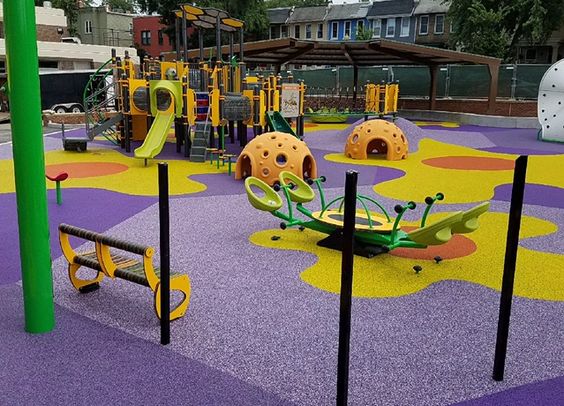
While designing and constructing outdoor or indoor playgrounds for backyards or theme parks, there are countless factors to remember — from the number and the kinds of equipment for the kids playing there to their safety. Most traumas occurring there are caused by falling, so having a cushioning playground flooring surface able to withstand and soften any fall is a must.
Surface coating for playgrounds can come in a variety of types and prices. It is, however, crucial to understand that a more expensive material isn’t always a bad deal, as due to its high quality and long lifespan, you will not need to constantly maintain, replenish, and replace it, resulting in way less spending over time. On the other hand, cheap playground surfaces will surely cost more in the long run.
This article will parse the most affordable playground surfacing materials, helping you make the best choice for your case.
The most affordable playground surfacing materials
First, it’s crucial to figure out the two main types of playground surfaces: loose-fill and unitary.
The structure of loose-fill surfaces consists of multiple small components, such as engineered wood, fiber, sand, or rubber mulch. These surfaces can be a go-to choice due to their excellent shock absorbance and affordability. On the other hand, if you go for such type of playground surface, you should acknowledge that it requires regular upkeep.
On the other hand, you can go for a unitary surfacing, which looks like a solid and smooth surface. The first instances of unitary playground surfacing that come to mind are turf, rubber tiles, and poured rubber or concrete. One benefit of unitary surfaces is their inclusiveness, owing to how safe and comfortable they are for people with mobility equipment. The main reason people choose not to use unitary surfacing is their high initial cost, but if you consider how long-lasting they are and the minimal maintenance they require, the price might seem lower.
Let’s explore some of the most affordable playground surface types.
1. Poured-in-place rubber (PIP)
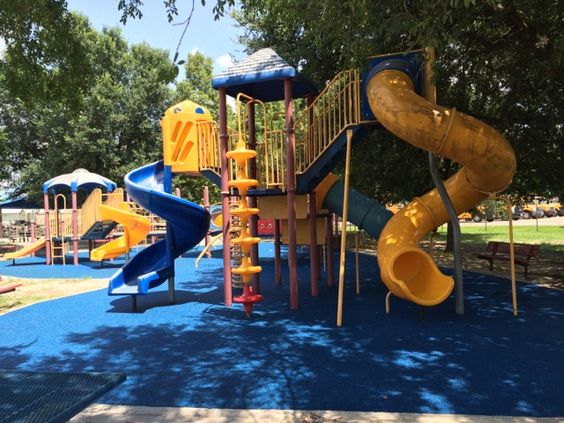
Poured-in-place rubber for playground surface has proven to be one of the most cost-efficient materials. Do not let its initial installation cost scare you away – it will all pay off when you forget about maintenance bills. Such durability is achieved through the mechanisms of installation, which include pouring in two layers of rubber: the base, which consists of shredder rubber, and the topcoat. Moreover, they are poured on-site, forming a perfectly flat surface for any shape or terrain, creating a smooth and safe playground space. Frequently, PIP surfaces are made out of either natural or recycled materials, adding to their sustainability.
In addition to that, PIP is an excellent choice if you’re looking for safe and accessible surfacing. Rubber is naturally slip-resistant, while rubber’s soft and absorbing nature makes it a great cushion, preventing traumas even after serious falls. At the same time, the rubber playground surface is solid and stiff enough for children who use mobility devices and have walking difficulties. Moreover, rubber is one of the most customizable options – whatever colors, shapes, and designs you have in mind – rubber will realize them.
2. Engineered wood fiber (EWF)
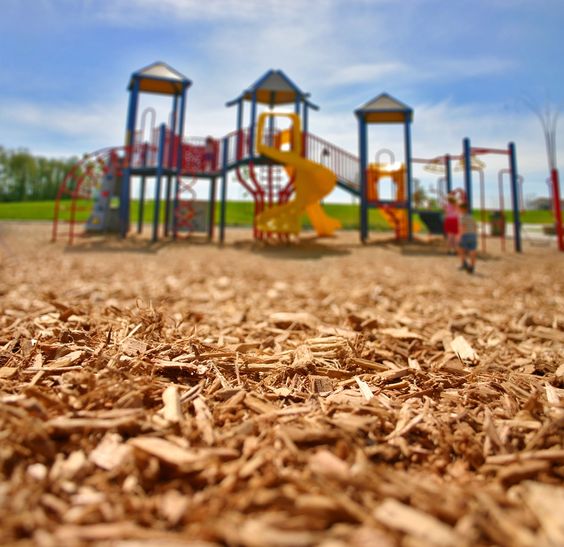
Another affordable playground surface material, which is even more eco-friendly, is EWF (engineered wood fiber). To avoid confusion with wooden chips, EWF undergoes additional processing, making it softer and removing any bark or twigs.
However, there are a few caveats in using EWF, as it requires way more maintenance than PIP due to it being a loose-fill material. First of all, playground equipment is sure to disrupt the integrity of the mass, making it form hollows and bumps, often even sending it flying outside the playground. Due to this factor, it is crucial to establish regular maintenance, refilling, and raking of the EWF. In addition, unlike other playground surfacing materials, this one is inaccessible for people with mobility equipment, making you put extra effort into making your playground ADA-compliant.
3. Pea gravel
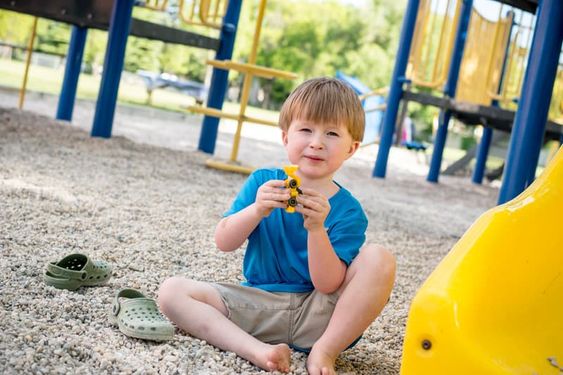
Pea gravel is an incredible material if you are looking for a naturally beautiful, safe, eco-friendly, and inexpensive playground surface. It consists of tiny (⅛ to ⅜ inch in diameter) smooth stones, mostly found near water. They come in numerous natural colors, mostly from white to brown.
Playground safety is usually a top priority, and pea gravel is rightfully considered one of the safest and most affordable options. If it is maintained at a depth of at least 12 inches, it can absorb falls well while keeping the playground safe from any synthetic. In addition to that, gravel excels at protecting the surface from the development of germs or the forming of puddles due to its outstanding drainage properties.
However, pea gravel is still a loose-fill material, meaning that placing it in high-traffic areas requires extra upkeep, calling for regular refilling and raking.
4. Synthetic turf
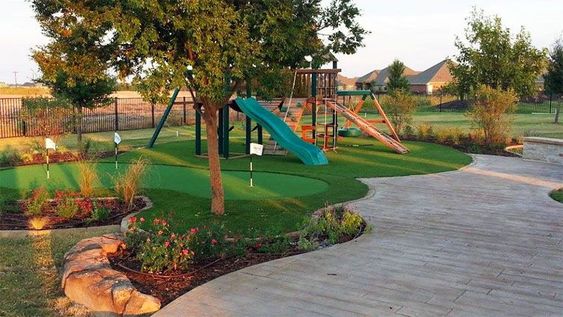
Another common surfacing choice for numerous playgrounds is synthetic turf (a.k.a. artificial grass). Polyethylene and polypropylene are the most common materials used for producing synthetic turf. Multiple layers of synthetic fibers provide proper fall cushioning.
Synthetic turf surfacing is a great alternative to natural grass. It is a much more affordable option to install and maintain than the natural grass — artificial turf doesn’t require mowing, watering, or pesticides. In addition, it’s allergy-friendly and free of insects.
On the downside, artificial turf tends to quickly absorb heat and get significantly hotter in direct sunlight, making such a playground uncomfortable to use in the hot months.
While artificial turf is more expensive than loose-fill surfacing options, it doesn’t require much upkeep, making it a more affordable playground surface option in the long run.
5. Sand
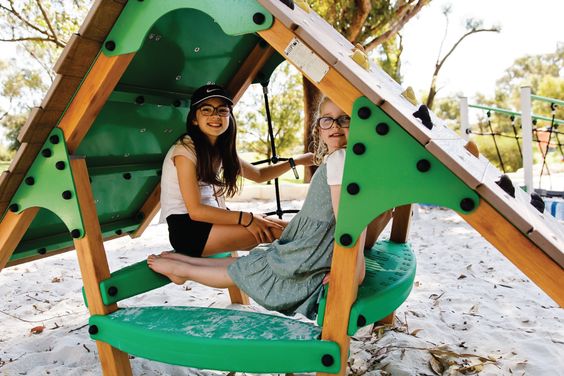
Sand is a natural, inexpensive material that provides proper impact absorption if the correct depth is maintained.
This option has a lower initial cost than any other type of surfacing on our list; however, it has more downsides. Sand is the most high-maintenance option since it requires frequent raking and replenishment. Next, it isn’t ADA-compliant, meaning such a playground is inaccessible to people who use mobility devices. Moreover, sand attracts animal waste and insects and can conceal hazardous objects.
So what is the most affordable playground surface?
As already mentioned, affordability doesn’t always mean low upfront costs. If we consider the installation cost only, sand and engineered wood fiber are indisputable winners. However, these options can be costlier in the long run since they require regular refills and routine maintenance.
On the other side, if you focus on long-term cost-effectiveness, poured-in-place rubber is a wise choice. While it’s not the cheapest playground surface at first sight, you can forget about the costly upkeep and refills for years by going for poured rubber.
How to choose the best surfacing material for playground — Safestep recommendations
Now that you know all the ins and outs of the most affordable playground surfaces, there are still some aspects to consider for playground designers when choosing the surface material for the playground:
- The height of your playground equipment — different surfaces come with various elevated impact attenuation;
- ADA compliance;
- Maintenance — before making your final decision, make sure you’ll be able to afford regular upkeep for surfaces that require it;
- Design to match the overall style of your playground.
Which playground surfacing material needs minimum maintenance?
Poured-in-place rubber surfaces require low maintenance — they are easy to clean and don’t require ongoing upkeep.
